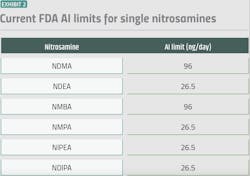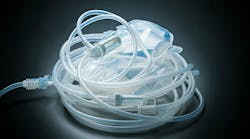As the nitrosamine story continues to unfold, global health authorities have united in requiring that drug product manufacturers complete comprehensive risk assessments of all drug products to determine the potential for nitrosamine impurity formation in their products and to use a risk-based approach to control nitrosamine impurities.
Although a large focus for risk assessment has been placed on synthesis and structural evaluation of the active pharmaceutical ingredient (API), it is critical that drugmakers also consider excipients (either containing nitrosamines or reactive amines), the drug manufacturing process, and even the drug product packaging contributions to the overall equation. Companies big and small are taking on this challenge from different directions and with vastly different weapons and strategies. But ultimately, navigating nitrosamines will involve a comprehensive approach to both risk assessment and mitigation.
The backstory
Beginning in July 2018, valsartan products were subject to recalls due to N-nitrosodimethylamine (NDMA) contamination, as reported by the Food and Drug Administration (FDA). In April 2020, the U.S. FDA posted a press release in which the agency requested drug manufacturers to immediately withdraw all prescription and over-the-counter drugs containing the API ranitidine from the market due to NDMA contamination. Since then, nitrosamine contamination has also been reported in nizatidine, rifampin, metformin, rifapentine, varenicline, irbesartan, sitagliptin and other critical APIs and drug products containing those APIs. Nitrosamines are considered a “cohort of concern” as defined in the ICH M7(R1) Assessment and Control of DNA Reactive (Mutagenic) Impurities in Pharmaceuticals To Limit Potential Carcinogenic Risk scientific guidance.
Nitrosamines as a category of chemical compounds are a probable human carcinogenand therefore the risk of their presence in drug products should be assessed to enhance drug product safety. As stated in an IPEC publication on nitrosamines,“The most substantial risk for the presence or formation of n-nitrosamines in medicinal products comes from the confluence of three factors: A nitrosating agent; a secondary, tertiary amine or quaternary; appropriate conditions (for example elevated temperatures, acidic conditions, liquid phase) for the aforementioned to react.”
FDA has provided a representative reaction for nitrosamine formation (see Exhibit 1). FDA guidance also provides published acceptable intakes (AIs) for seven simple nitrosamines (see Exhibit 2). These impurities have established toxicology information upon which the AIs were derived, but there are nitrosamine impurities that can form other than those seven listed in the FDA guidance. Nitrosamine impurities that share a significant structural similarity to the API are termed ‘nitrosamine drug substance-related impurities,’ or NDSRIs. The risk of these impurities or any other nitrosamine impurities forming should be assessed, their presence quantified, and action taken to reduce or remove these impurities if needed to bring the drug product within safe limits.Risk assessment
API and drug product manufacturers should evaluate their materials and their processes to perform a comprehensive assessment for the risk of forming nitrosamine impurities. Ask questions to evaluate the entire supply chain including: Does the API process use recovered materials (solvents, catalysts, reagents) or intermediates that could be contaminated with nitrosamines or amines? Is there a possibility of cross-contamination in a multi-purpose facility? Regarding the drug manufacturing process, consider the following actions: Review the individual properties and structures of the starting materials, including intermediates, final API and excipients. Review process conditions (temperature, liquid phase, acidic conditions) that may be conducive to nitrosamine formation. Finally, determine whether nitrosamine impurities could be formed and confirm whether nitrosating agents are used or are present in the process. For the finished drug product, determine which, if any, degradants and impurities are formed during stability. Consider whether there is potential for nitrosation to occur once API and excipients are combined. And be sure to review whether there are residual nitrites or other nitrosating agents in the drug product formulation that could trigger nitrosamine formation during shelf life.
This information is used to compile the risk assessment and determine if a risk is present for nitrosamine impurity formation. If the risk assessment determines that there is indeed a risk of nitrosamines present in the drug product, then manufacturers should proceed to confirmatory testing.
Confirmatory testing
If the risk assessment has determined a risk of nitrosamine impurity formation, then confirmatory testing should be performed to verify that the nitrosamine impurity is present and if it is present at an unsafe level. The type of impurity — if it is a simple nitrosamine or NDSRI — will inform the process for confirmatory testing. If the risk assessment determined a risk for formation of the simple nitrosamines listed in the FDA guidance, the USP and the European Pharmacopoeia have both published chapters on testing of these impurities and offer certified reference standards to assist with the confirmatory testing step. However, if the risk assessment determined a risk for formation of an NDSRI or other nitrosamine impurity not listed in the FDA guidance, the manufacturer may have to develop a new testing procedure or method. In addition to developing a new test method, there may not be much publicly available information for the nitrosamine impurity, such as for NDSRIs, where an AI limit cannot be easily determined upon which to anchor the development and validation of the new test method. For these impurities, manufacturers may be able to employ a read-across surrogate approach to derive an AI for a novel nitrosamine (e.g., NDSRIs) for which safety data has not been generated/published. Consideration should be given to degree of substitution, steric bulk, electronic influences, potential for metabolic activation, stability/reactivity of the resulting metabolites, and overall molecular weight, when comparing the NDSRI to the proposed surrogate.
Selected surrogate carcinogenicity data (basis for AI derivation) should be from a well-conducted and defensible study to use a structure-activity relationship (SAR) approach. A recently published update to the EMA guideline question and answer document on nitrosamine impurities in human medicinal products10 provided an updating listing in an appendix in the response, listing several nitrosamine impurity AI limits, including some NDSRIs based on surrogates using a SAR/ read-across approach. This same question response also outlined the use of the Carcinogenic Potency Categorization Approach (CPCA) for nitrosamines and provided guidelines for an enhanced Ames test as possible approaches. The recommendations to use the CPCA approach and publication of the enhanced Ames are welcome developments in the approach to establishing limits for NDSRIs that will hopefully be adopted more broadly in the future to assist manufacturers struggling with setting AIs for NDSRIs and other novel nitrosamine impurities.
Approaching FDA
Once a manufacturer understands the nitrosamine impurities that may be present in their drug product and the real or potential impact on the drug product’s safety, they may find that a conversation with FDA is in order. Firstly, FDA appears to be amenable in proceeding with a patient–centric, data-driven approach based on favorable benefit/risk assessment for products that are on the market. The agency has stated that “FDA has in the past permitted manufacturers who found levels higher than the acceptable intake in certain products and batches to continue to distribute batches to alleviate a shortage, and we will continue to evaluate each product and contamination on a case-by-case basis with a goal of balancing risk to exposure with the benefits from continued use of the drug.”9 That said, the key to getting FDA’s agreement to the proposed approach is timely and transparent communication. Once a manufacturer has gone through the ICH M7(R1) exercise of determining the risk associated with the nitrosamine or nitrosamines, FDA should be contacted regarding the proposed AI limit to ensure agreement with the approach used to derive the proposed AI. Application holders can reach out to the regulatory project manager at FDA to discuss the appropriate submission type/venue for the proposal for any pending or approved application. Alternatively, manufacturers can also ask via CDEROPQ-Inquiries@fda.hhs.gov, including for instances where more than one impurity is found, and the agency will route the question to the appropriate FDA office. If drug product batches with unacceptable levels of nitrosamine impurities are already in distribution, the FDA advises that the drug manufacturers contact the agency so that the agency can determine the regulatory action for the specific drug products. Any drug product batch found to contain levels of nitrosamine impurities at or above the recommended AI should not be released for distribution. Manufacturers should contact the FDA if a recall is initiated.
Mitigation
As the assessment encompasses every aspect of the product, so should the mitigation evaluation and approach. If the risk originates with raw materials or excipients, a strong supplier qualification program will help. Here are some tips on creating a strong qualification program:
• API suppliers: Minimize potential for contamination and residual solvents that may lead to formation of nitrosamines by optimizing the API process during route of synthesis/evaluate quenching steps. Audit supply chains, evaluate reprocessing, and evaluate alternate suppliers.
• Excipient suppliers: Use IPEC questionnaires and evaluate alternate suppliers.
• Formulation evaluation: If the nitrosamine is an NDSRI and might form or increase product storage, a manufacturer may need to investigate the possibility of adding an antioxidant (Vitamin C or Vitamin E) to the formulation to inhibit formation of nitrosamines and investigate the possibility to run the process under neutral or basic conditions.
These changes should be assessed and implemented using the manufacturer’s change control process. Keep in mind that any changes to the conditions of the application (NDA/ ANDA) should be reported to FDA as required by 21 CFR 314.70 and 314.97 for commercial drug products, and per 21 CFR 314.60 and 314.96 for pending products. Currently, these changes are to be submitted to FDA by October 1, 2023.
Communication and transparency
While some companies are using similar approaches, and others using very different approaches for assessment and mitigation, it is important to remember that each assessment and mitigation strategy can and should be different. Each manufacturer’s approach should be applicable to the product, the API, the excipients and the manufacturing process for that product. Refer to the resources available — some of them referenced in this article — and be transparent with the agency. The nitrosamine story is evolving and communication and negotiation (backed by data!) will be the best option to navigate these waters.








